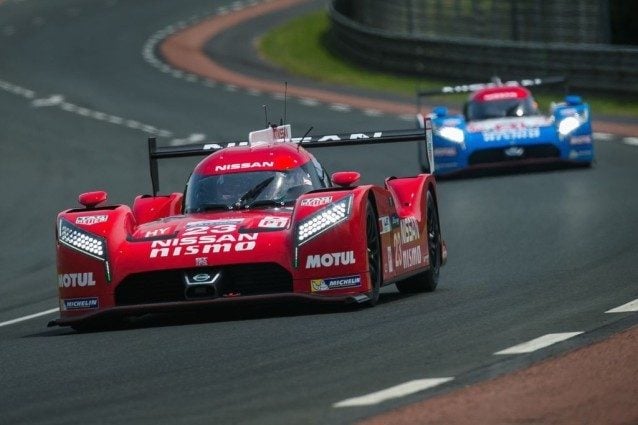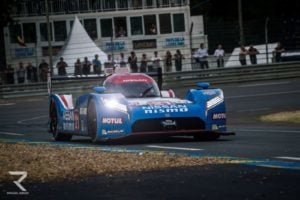
It didn’t exactly have the most successful start to life, but hopes for 2016 were much higher.
The Nissan GT-R LM P1 was another attempt to take on the rules of top level endurance racing with a slightly different angle from Ben Bowlby, the man behind the original and beloved DeltaWing. Exploiting a blindspot in the regulations, the car was created as a front-engined and front-wheel drive effort to take on the established and less imaginative mid-engined cars.
 However, it was beset by technical problems from the start, with an extremely short gestation period between its first reveal and the start of 2015’s FIA WEC season, which lead to the car being withdrawn until the 24 Hours of Le Mans.
However, it was beset by technical problems from the start, with an extremely short gestation period between its first reveal and the start of 2015’s FIA WEC season, which lead to the car being withdrawn until the 24 Hours of Le Mans.
It became a fan favourite thanks to Nissan’s engagement on social media and openness about the project’s technical aspects – against the usual secrecy and guardedness – even being added to Gran Turismo 6 in June 2015 as part of the GT Academy competition, but this didn’t help it on track.
The teething problems hadn’t been fixed by Le Mans, and the car had to run hamstrung without any electric power. It didn’t slow it down much, as the car was hitting speed traps at the same pace as its peers, the clever aero proving to do exactly what Nissan had said. What did slow it down was accidents and reliability – none of the three cars reached a classified finish.
 Nissan didn’t enter the car in the remainder of the FIA WEC and Darren Cox, Nissan’s motorsports director, reminded us that it was always a 2 year project to bring the Le Mans title back to Japan. However Darren himself left in November, leaving question marks over the project’s fate and GT Academy itself.
Nissan didn’t enter the car in the remainder of the FIA WEC and Darren Cox, Nissan’s motorsports director, reminded us that it was always a 2 year project to bring the Le Mans title back to Japan. However Darren himself left in November, leaving question marks over the project’s fate and GT Academy itself.
The plug has now sadly been pulled:
The teams worked diligently to bring the vehicles up to the desired performance levels. However, the company concluded that the program would not be able to reach its ambitions and decided to focus on developing its longer term racing strategies.
Without the three Nissans on the grid and only two-car teams from Porsche, Audi and Toyota, the LMP1 class is looking a little bare for 2016’s Le Mans 24 Hours, especially with the grid increasing from 56 to 58 cars. The Nissan was a big draw for the fans too, something Le Mans will miss.
See more articles on 24 Hours of Le Mans, Darren Cox, FIA World Endurance Championship, and Nissan.






I think keeping the production and public is what really hurt its project.
The same thing happened to the Aston Martin AMR-One which killed Aston Martins LMP1 Program.
Well at least if there is another GT Academy we don’t have to drive that POS. I really hate
that car.
Nissan engines are in the majority of LMP2 cars, don’t forget.
The last obstacle has been taken out of the way. Nissan f1
@All Your Base
The thing about Mercedes is that they stated categorically that they would NEVER return to Le Mans. Nissan was quite successful in sportscar racing in the late 80’s, and although this LMP1 program was not successful in any way, there is still reason to believe that they might return one day. If Mercedes Benz EVER returns to Le Mans, well then, they are liars, by definition.
Time to focus on a NASCAR team to keep up with Toyota.
Boogity, Boogity, Boogity.
I think the Renault F1 project took the LMP1 budget.
This is a shame, but should have been expected.
i wish they would let us have the option to buy the lmp1 in that blue decal (tho I would never use it)
Not impressed. This project has been a joke since day one.
They tried to be different just for the sake of being different.
This is what happen when you pretend marketing to be more important than engineering.
I expected it, but it is quite a bummer to me. Nissan spent months of effort into the car, and it has cool innovations, like making the FF drivetrain work in an LMP1, and a 500HP KERS system. Think of it as the modern day Chaparral 2J or Tyrrell P34, which innovated, but unfortunately failed. I really wanted the GT-R LM Nismo to win the Le Mans this year, but reliability and the lack of pace made the GT-R LM project nothing short of a failure. And the worst part about this is that Nissan said they were improving the car for 2016. So, I hope Nissan doesn’t go all Mercedes-Benz and quit Le Mans for 30 or so years.
There is no comparison between the P34, 2J and this Nissan. For one thing, the P34 actually won the Swedish GP where they finished 1-2. It also achieve 14 podiums in 30 races and Scheckter took it to third overall in 1976. It was a very competitive car. It was the lack of development of the little front Goodyear tires that really held it back from being an even bigger success. The 2J was 1-2 seconds faster in 1970 in the Can-Am series but was plagued with mechanical issues. SCCA saw the writing on the wall, meaning if they sorted out the mechanical issues, everybody would have to design a similar car to compete and they didn’t want that, so they outlawed it at the end of the season.
This really is an incredible bummer. Just like most other fans, I was really fascinated by the openness and hearing about all the fancy, hard to understand engineering. It was quite ambitious to try and make FF work on a modern LMP1, but they got to a respectable point, so I still enjoyed it while it lasted.
Really wish we could have played with next evolution of the car, but from the sounds of it, the car won’t be developed any more unless a miracle revival occurs. Hoping they still go for LMP1 though. Guessing they might focus on GT3 for 2016, and maybe by 2017 or 2018, HOPEFULLY have a more practical LMP1. Even if it’s not as quite as ambitious engineering wise, it’s very cool how the Japanese go about Le Mans.
Ideas come and go, some are great other fails, but If you don’t try ,you’ll never know.
I liked idea that car was FF (+electric)and despite knowledge, it made some sense listening to tech-explanation why they decided to do that and why they thought car will benefit from FF, but I did wonder how that all would end.Unfortunately , 24h was a fail and car simply is not competitive .End of this story, now it’s time for a new one.
Revolution failed.
More like an evolution of an old and decidedly bad idea. Front engine/driven wheel cars have too many disadvantages. Its not a coincidence that all open spec race cars put the engine in one particular place and use rear or a rear bias drive system.
Not terribly surprising considering the mechanical gremlins it’s faced. Not as big a loss as the Peugeot’s were IMO.
Understatement… “Not terribly surprising…”. Its a LMP1 car that was getting its rear-end handed to it by LMP2 cars. They could have gone quicker in LMP Challenge specs racers with a little more motor.
R.I.P Kazboat’s Big Brother :(
Couldn’t they have just tried an FR build instead?
Too much money spent on the bad idea.
No respect. Are you one of those “fail-wheel drive” people?
The biggest perk that I can see of that FF layout is that the car has much wider tires on the front amd extensive downforce on the nose. Great for low traction surfaces such as a rainy road! The GT-R was actually a brilliant idea, considering how FFs usually are (fuel efficient, great low traction grip, etc) and considering how unpredictable LeMans can be.
This is basically the 2015 equivalent of the Chaparral 2J: A great idea which wasn’t given enough time to grow to full potential.
^…except it didn’t perform well and the radical technology (front-wheel drive) hasn’t been banned yet.
^That bit is true. It’s still kinda out there, though.
After the screw-ups this year, I have a feeling that the loophole isn’t going to be closed.
Not true about the comparison between the 2J and this Nissan. The 2J was hands down faster than every other car on the grid from the outset and only mechanical issues kept it from completely dominating Can-Am. It was outlawed after one season because the SCCA saw the writing on the wall, not because it was uncompetitive and a poor choice of tech like the Nissan.
Actually, Johnny, the SCCA was pressured by McLaren to ban the 2J in order to keep it from dominating the series…Ironically, McLaren was dominating the series before the 2J came around.
As for the GT-R LM, it was a lot of wasted potential… Nissan should’ve given it another year.
In GT6 it’s actually pretty quick at 650pp.
Noooo!!!
” … to take on the established and less imaginative mid-engined cars. ”
sure it takes a lot a imagination to expect a FWD LMP1 to win Le Mans against Audis and Porsches…
i’m happy Nissan decided to get serious by giving up on that car and wish them the best for the future with a real car!
It was also slowed down by horrific apex speed and suspension that had a panic attack every time it got close to a kerb, totally didn’t see this cancellation coming! /s
Exactly. Not to mention terrible front tire life. No big loss in my mind, some may have thought it was ground breaking, but the reasons for the current formula of sports car engineering are well proven and this was doomed from the outset.
I take it you drove the real car then? Only so much info a video game will present you with over driving the actual thing on real tarmac. Let’s not let our armchair hysteric leading us to think that what we experienced in the game exactly mimics what the real deal is like. It’s a simulation but the real car could have been a vastly different beast underneath your seat.
According to this line “The teething problems hadn’t been fixed by Le Mans, and the car had to run hamstrung without any electric power. It didn’t slow it down much, as the car was hitting speed traps at the same pace as its peers, the clever aero proving to do exactly what Nissan had said.” Horrific apex speed in the game, perhaps the real car had those issues am I right?
@SavageEvil I have never played the Nissan ingame, I stopped playing GT6 some time before it was included. It’s awful suspension and apex speed are known facts and were very apparent quickly during it’s first real life outing. You know, Lemans? The one one that was broadcast and we could all watch for ourselves?
I too have never driven this car in GT6, nor actually played GT6 for a very long time. I did however watch the race… Did you Savage?